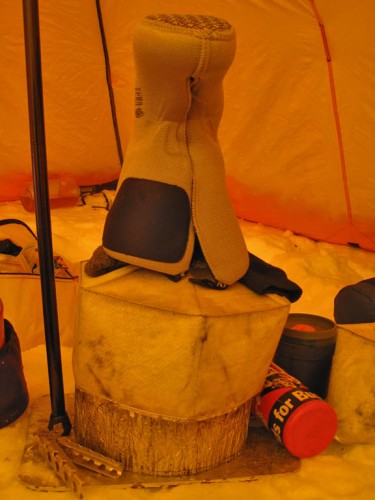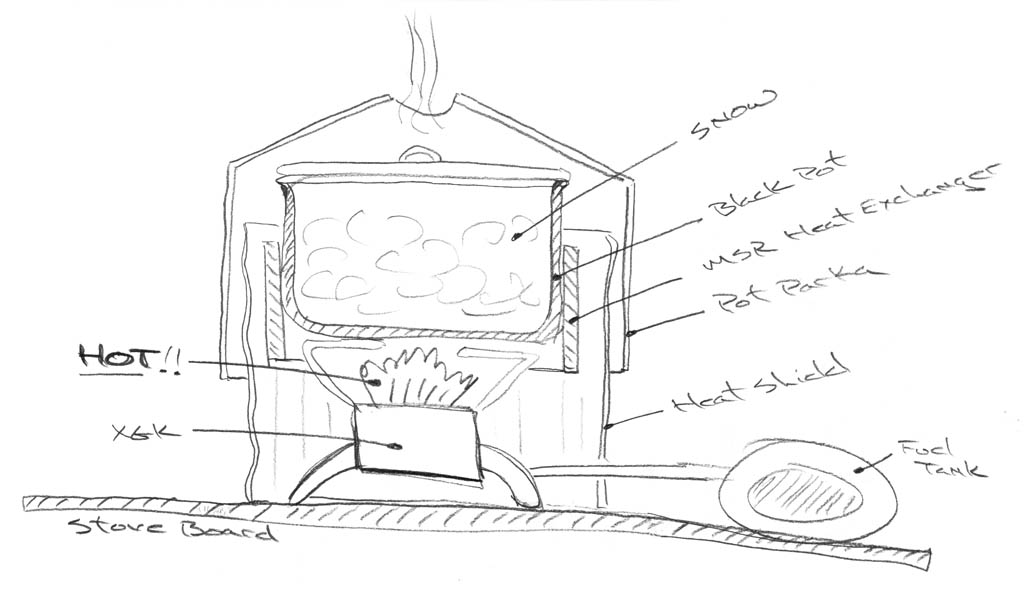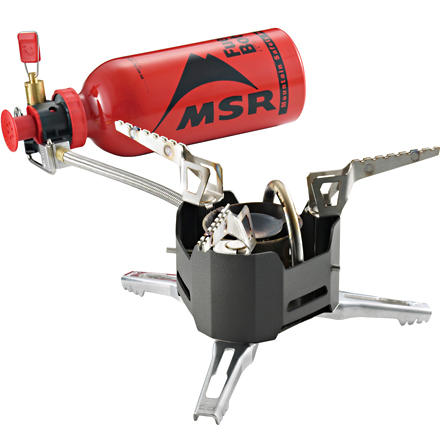Expeditions – Stove Set-Up
Stoves are the heart of any expedition, as without them, you are not going to be melting snow for drinking water or cooking food – at least not very fast. No food & no water equals no movement. Within the grand stove category, there is really only one that matters, the Mountain Safety Research (MSR) XGK. This is the Grand Master of all stoves as it is incredibly hot, durable, capable of burning all sorts of fuels and works well at altitude. Critics will say that it is noisy and doesn’t simmer, but when you are melting two gallons of water per day, so what. Hearing aids are cheap and the Zen Master XGK user can get a simmer by adjusting the tank pressure. Delicately browned pancakes? Pfft – no problem.

There's a stove in there somewhere... The XGK set-up in action while it melts snow, dries socks and forces hot air through a wet pair of liners.
By itself, the XGK kicks ass, but with a little extra help, its efficiency goes into the stratosphere. Starting with an aluminized stove board (future posting), add the standard-issue heat reflectors, a big black pot, MSR Heat Exchanger and a Backpackers Pantry “Pot Parka” and now you have the backcountry equivalent of a Viking stove and central heating.
Oh, and of course, cooking in the tent, or the vestibule is the only way to go. :)
Edited to add: With this set-up, I plan on 6 fluid ounces, or .18 liter per person, per day for “heavy burning” winter camping, ie: melting snow, lots of cooking, etc.. For reference, the official MSR recommendation is 15 fl oz pppd, or 11.25 with a heat exchanger, so about half as much fuel and thus weight is needed.
________________________________
Please help support StraightChuter.com and get a flame-throwin’ MSR XGK EX Multi-Fuel Stove on sale now at Backcountry.com. Click on the photo below…
Category: Expeditions











doesn’t the steam from the boiling water make your liner more wet?
You can keep it on there until the snow melts down a bit and starts to make steam. Relatively dry heat until the snow melts.
Hi Steve – Like Dun mentioned, you have to keep an eye on the boilage, but in the 15-30 minutes it takes to turn snow into water, then get the water to boil, you capture a lot of useful heat. In general, as soon as I get the first boil bubble, I turn the stove off, or switch out pots.
Andrew- Have you ever made and used a Reflectix pot cozy? It’s nice to still have have hot water for a while after it’s off the stove. I have also made one to fit “just add water” meals. It’s just an envelope or pouch that the bag of food slides into and boiling water added to the bag in the pouch and closed up with glued on Velcro tabs. You can buy them pre-made, but they are so basic a two fingered gnome could make one for cheap.
I have never been to Alaska, so I was wondering how you keep the water hot for a second cuppa joe? Speaking of coffee, what is your brewing method in the mtns (assuming you drink coffee)?
Hi Ralph – I try to limit my coffee intake to less than a gallon a day, but sometimes I exceed that. :) For expeditions, I drink (shame), instant, unless someone else is providing the grounds. I’ve just found that bringing pounds of coffee, filters, spillage, dealing with the grounds, etc., is kind of a pain.
I haven’t heard of or seen the Reflectix pot cover – sounds interesting. The BPP Pot Parkas seem to be getting harder to find, and for some reason, they work well for years, then burst into acrid smoldering smoke and need to be tossed.
I try not to boil too much water, or store it in an insulated Nalgene. We brought a thermos on a trip to Patagonia which worked great for matte, which we had plenty of down time to drink.
Hi Andrew- I have this stove and love it, but the only time I have had trouble with is was when I was hitchhiking through Norway and had some Coleman liquid stove fuel. The thing would light but not gas-i-fy and I couldn’t get any heat to boil noodles. I have since cleaned it and used MSR Superfuel back in the states and have had no troubles. Have you had any fuel types not work or recommend not using in the XGK? Also, how often do you clean the gas line?
Thanks
Hi Jon – I may be confusing my stoves, but I *think* you can change jets on the XGK..? I’ve burned a variety of fuels in it, but remember having a really hard time in Iceland finding something that would work.
I bring a repair kit with me on most trips, and the main issue always seems to be the little gasket at the pump end. Aside from that, the stoves seem to work really well. I think I’ve cleaned the fuel lines once, if that.
What are the general rules with regards to cooking with a stove in a tent? Everything I’ve ever read seems to indicate that it’s a bad idea, but I’ve also seen ample pictorial evidence suggesting it’s doable…
Muchos Gratias
Hi Jonny – If possible, light it outside, then bring it into the vestibule and be careful about keeping it away from the tent walls. Once it is up and running, they seem to be pretty stable. Pyramid style tents (no floor) are ideal for cooking. I rarely cook inside of the actual sleeping part of the tent, but if I do, I clear everything away and am very careful about venting.
With the height of this setup, I am reminded of the Flextrek 37 trillion…
It’s a bad idea. I’ve never done it so many times that I can’t imagine not doing anything else in the winter. I really can’t imagine doing it in a Megamid – it’s entirely too convenient.
If you do decide to do it, note that your tent may vaporize in an instant if you screw up.
Andrew – what does your full fuel efficiency-enhancing system weigh?
I’ve been using this set up for years except with the MSR Whisperlite stove. Cooking inside a tent is DANGEROUS. However it is reasonable if you understand that you need adequate ventilation to prevent carbon monoxide poisoning and that if there is a fuel leak or flare up you need to have an instant way to evacuate the stove from the tent. Generally I only use a stove inside a vestibule and then only if I am in a blizzard. Someone absolutely has to monitor the stove at all times and have a pre-rehearsed plan to move the stove quickly. More than one climber has suffered because they have fallen asleep and the stove has tipped or flared or the wind has shifted and is now blowing the CO directly into the tent.
Awe inspiring life, lovely article,from a couch potatoe
just bought multi fuel stove [msr xgk ex]for my trip to iceland in july [cycle/camping across the interior]but after reading im a little uneasy about not being able to get any fuel for the stove,and if i did would the thing light…from the above it sounds like some have had problems in this respect…would i be wise to take a canister stove as well
Hi Paul – Iceland is the land of MANY petrochemicals and it is more a matter of finding the right one, or at least knowing what it is called. We ended up using our XGK’s with regular gasoline (unleaded?) and changing out the jet. I forget exactly which jet it is, but I think the XGK’s only come with two of them, so it is the non standard one. This ended up working well, but it put out a TON of black smoke in the start up process, which gets all over everything unless you light it outside, let it get up to temp, then bring it inside the cook tent (or, cook outside).
After our trip, a friend from Iceland wrote me and said that they do indeed have what we would call “white gas” or camping gas, but it had a different name. You might also try to get it in some of the bigger cities – we waited until we were in a small little town and our options were limited.